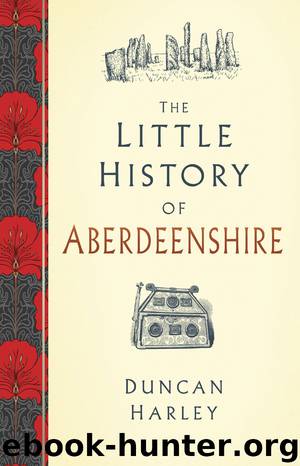The Little History of Aberdeenshire by Duncan Harley

Author:Duncan Harley
Language: eng
Format: epub
Publisher: The History Press
THE RAILWAY AT ABOYNE
For almost half a century, the Deeside village of Aboyne marked the end of the turnpike road from Aberdeen. By the 1850s, however, pressure from local stagecoach operators and commercial carriers led to the extension of the turnpike as far west as Braemar. Earlier landowners and local visionaries had considered the digging of a grand canal linking Aboyne with Aberdeen but this project failed to gain popular support due to engineering issues, including the need for costly aqueducts. Alongside road improvements there was a need for improved river crossings. There were many ferries operating on the Dee, most were small craft operated by local entrepreneurs – sometimes called ‘Boaties’ – who for a small fee would row folk across the river. The ferry at Aboyne was typical of the breed and crossed the Dee near the Old Boat Inn on Charleston Road.
The boatie ferry at Aboyne operated until 1827 when a tragic accident, during the October St Michael Fair, occurred. Despite a sudden spate, the boatman left the north bank with his heavily overloaded boat crammed to the gunwales with late-night revellers. Near the south side, the ferry overturned and all on board were thrown into the water. Most scrambled ashore but a woman and her daughter drowned. Word of the tragedy reached Aboyne some three hours later, when the boatman himself brought the news having hiked 12 miles back to Aboyne via the Potarch Bridge.
The incident prompted the then Earl of Aboyne to fund a suspension bridge over the river. The present Aboyne bridge is the fourth to be built on the site. For a brief period after the railway arrived in 1859, the town became the railhead of the Royal Deeside Line. Aboyne found itself playing host to Queen Victoria, her entourage and her distinguished visitors as they disembarked from royal trains to stop over at the likes of the Huntly Arms – perhaps Scotland’s oldest coaching inn – before travelling on to Balmoral Castle by road. With the arrival of the Deeside Railway to the town, agricultural goods, foodstuffs and of course timber, which in pre-railway days had been floated down the Dee, now gravitated to the railways. Steam trains slashed journey times and as transport costs decreased tourism began to increase.
The combination of Sir Walter Scott’s romanticised tales of broadsword-wielding tartan-clad Highlanders plus the attraction of hunting, shooting and fishing proved irresistible and attracted hordes of tourists intent on sampling the Highland lifestyle. Aboyne benefited greatly and Queen Victoria’s royal romance with the Highlands added value to the Deeside brand. By the time of her death in 1901 the town’s population had more than doubled from a pre-railway 1841 figure of just 260 to 561. The 2011 Census records 2,602 residents. George Bradshaw’s General Railway and Steam Navigation Guide for 1863 records that Aboyne station ‘offers an excellent starting point for the tourist to visit the picturesque scenery extending between Ballater, Braemar and Balmoral’. Clearly George was intent on disturbing the monarch’s peace and quiet.
Download
This site does not store any files on its server. We only index and link to content provided by other sites. Please contact the content providers to delete copyright contents if any and email us, we'll remove relevant links or contents immediately.
| Africa | Americas |
| Arctic & Antarctica | Asia |
| Australia & Oceania | Europe |
| Middle East | Russia |
| United States | World |
| Ancient Civilizations | Military |
| Historical Study & Educational Resources |
Life of Elizabeth I by Alison Weir(2050)
The Invisible Wall by Harry Bernstein(1784)
Art of Betrayal by Gordon Corera(1413)
1916 in 1966 by Mary E. Daly(1256)
Thunderstruck by Erik Larson(1233)
The Decline and Fall of the British Empire, 1781-1997 by Piers Brendon(1108)
A Brief History of Britain, 1066-1485 by Nicholas Vincent(1022)
A Brief History of Britain, 1485-1660 by Ronald Hutton(994)
Guy Burgess by Stewart Purvis(988)
Mary, Queen of Scots by Weir Alison(978)
Henry VIII by Alison Weir(925)
The Last Lion 02 - Winston Churchill - Alone, 1932-1940 by William Manchester(919)
Fifty Years On by Malachi O'Doherty(882)
Lang Lang by Lang Lang(858)
1066 by Andrew Bridgeford(842)
Gimson's Kings and Queens by Andrew Gimson(838)
Coalition by David Laws(822)
The Last Plantagenet by Thomas B Costain(821)
London: A Biography by Peter Ackroyd(816)
